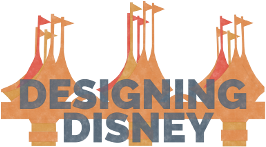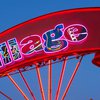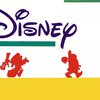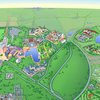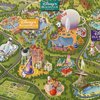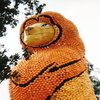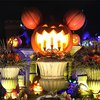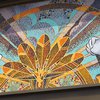Designing the Golf Disneyland Clubhouse
As previously discussed, Disneyland Paris (originally called Euro Disney) was conceived from the beginning as a compact version of Walt Disney World. The European resort was planned to contain the same amenities as its American counterpart: theme parks, resort hotels, campgrounds, recreation areas, a nighttime entertainment center and last but not least a golf course.

Today we shed light on a hidden gem of Disneyland Paris architecture: the Golf Disneyland Clubhouse designed by Gwathmey, Siegel and Associates (Gwathmey Siegel Kaufman & Architects today). This company also designed the Bonnett Creek Golf Clubhouse and the Convention and Exhibition Center at the Contemporary Resort at Walt Disney World.

The 11,000-square-foot clubhouse features changing rooms with showers, a pro shop, a restaurant-bar and kitchen, a conference room and administrative offices. Two exterior terraces provide good views to watch the golf unfold. The clubhouse is surrounded by three nine-hole courses (called “Alice”, “Peter” and “Winnie”, designed by Ronald Fream) and a training area.

The building’s exterior is characterized by three distinct roof forms: a barrel vault, a dome, and a curved, segmented shed. A vehicular entry porch with skylighted canopy extends through the building. It connects the different parts of the site and the building circulation systems.

The Golf Disneyland Clubhouse is – just like few other structures at Disneyland Paris – not themed. It is one of the abstract designs of the development (such as the original “Festival Disney”, the Toll Plaza, the RER/TGV station or even the corporate design discussed in previous articles). But why is this building not themed like the Parks or Hotels? It would have been a great opportunity!

The Golf Disneyland Clubhouse has an abstract design because the style of its architects is based on that of the quintessential modernist architect Le Corbusier (1887–1965). Modernist architecture is characterized by functional buildings that have simple forms and no decoration.
Fine examples of modernist architecture can be found in Boston (City Hall), New York (Seagram Building, Lincoln Center, the former World Trade Center) and Brasilia (the capital of Brazil built from scratch in 1956 on the principles of modernism).



The Golf Disneyland Clubhouse appears as a modernism-inspired collection of simple volumes (a pyramid, a dome, cubes and a barrel vault) in terracotta-ish red, shining white and soft yellow. No ornamental decoration is part of the design of the clubhouse.
But that shouldn’t necessarily be a bad thing! The humble shapes and subdued colors pleasantly contrast to the lush, green landscape surrounding it. And because of that, the building graciously leaves the center stage to its natural setting.
Just as the neutral corporate design of Euro Disney did not compete with the themed architecture but was subordinate to it, the clubhouse is secondary to its surroundings. It points out that this place is about the course and the game and not about vain architecture.

So, initially it may come as a surprise that the Golf Disneyland Clubhouse is not themed as a Southern plantation or an East Hampton mansion. The clubhouse is another fine example of the quieter designs of Disneyland Paris. But one has to appreciate that humble approach because it celebrates the beautiful French countryside and the exciting game called golf!
This article was written by our good friend Will. His fascination and appreciation for Disney started with the opening of Euro Disneyland in 1992. Coming from an American Cultural Studies background, Will today is most interested in the original concept of the Euro Disney Resort and the cultural messages that the Walt Disney Company wanted to convey about the United States back in the late 1980s. To Will, the 1992 Euro Disney complex is an outstanding example of postmodern architecture and culture, which should be maintained in and reconstructed to its original state as closely as possible. These concerns and interests lead the author to follow and support 'Designing Disney'. We would like to sincerely thank Will for the efforts that he has made in writing this very interesting article!
Credits
Photos:
- Nr 6: Anthony DeCusatis
- Nr 7: Sinakone
- Nr 8: Zelnunes
